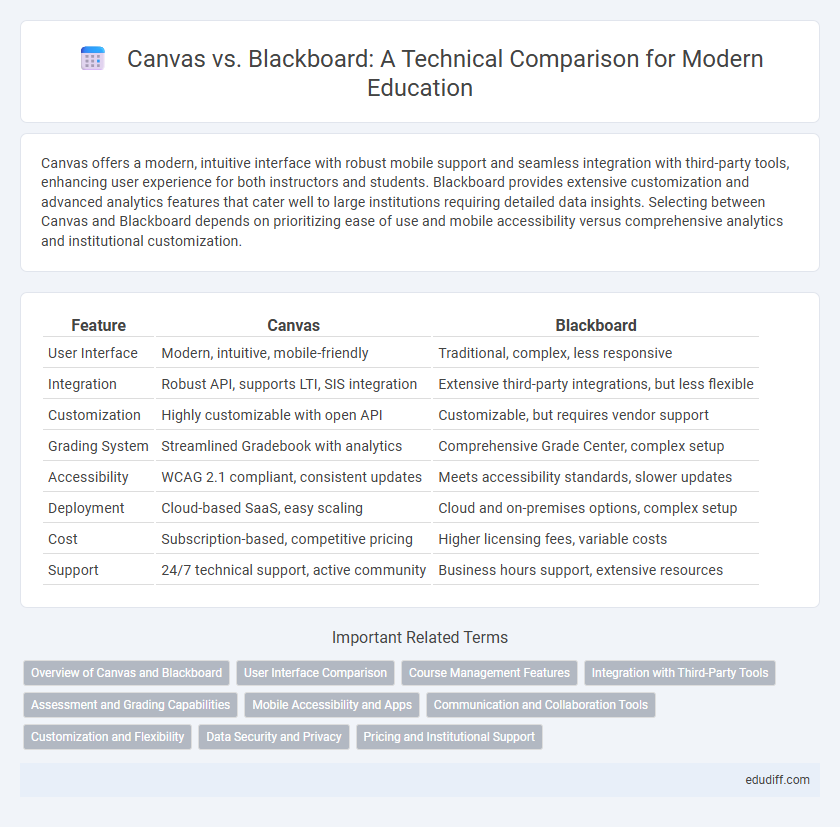Canvas offers a modern, intuitive interface with robust mobile support and seamless integration with third-party tools, enhancing user experience for both instructors and students. Blackboard provides extensive customization and advanced analytics features that cater well to large institutions requiring detailed data insights. Selecting between Canvas and Blackboard depends on prioritizing ease of use and mobile accessibility versus comprehensive analytics and institutional customization.
Table of Comparison
| Feature | Canvas | Blackboard |
|---|---|---|
| User Interface | Modern, intuitive, mobile-friendly | Traditional, complex, less responsive |
| Integration | Robust API, supports LTI, SIS integration | Extensive third-party integrations, but less flexible |
| Customization | Highly customizable with open API | Customizable, but requires vendor support |
| Grading System | Streamlined Gradebook with analytics | Comprehensive Grade Center, complex setup |
| Accessibility | WCAG 2.1 compliant, consistent updates | Meets accessibility standards, slower updates |
| Deployment | Cloud-based SaaS, easy scaling | Cloud and on-premises options, complex setup |
| Cost | Subscription-based, competitive pricing | Higher licensing fees, variable costs |
| Support | 24/7 technical support, active community | Business hours support, extensive resources |
Overview of Canvas and Blackboard
Canvas and Blackboard are leading learning management systems widely adopted in educational institutions for course delivery and management. Canvas offers a user-friendly interface, cloud-based architecture, and robust integration with third-party tools, enhancing accessibility and collaboration. Blackboard provides comprehensive features including detailed analytics, customizable assessment options, and strong support for blended learning environments.
User Interface Comparison
Canvas features a modern, streamlined user interface with intuitive navigation and customizable dashboards that enhance user engagement and reduce learning curves. Blackboard's interface, while comprehensive, often presents a more cluttered layout, which can challenge new users and slow task completion. Empirical studies indicate higher satisfaction ratings for Canvas UI due to its responsive design and accessibility features.
Course Management Features
Canvas offers a user-friendly interface with intuitive course creation tools, seamless integration of multimedia content, and robust grading options, enhancing instructor efficiency. Blackboard provides comprehensive course management features including adaptive release, detailed analytics, and customizable learning paths to support diverse educational needs. Both platforms support collaborative tools and mobile accessibility, but Canvas excels in simplicity and speed, while Blackboard is preferred for advanced customization and institutional scalability.
Integration with Third-Party Tools
Canvas offers extensive integration capabilities through its open API and LTI compatibility, enabling seamless connection with a wide range of third-party educational tools such as Zoom, Google Drive, and Turnitin. Blackboard supports numerous integrations as well, but its proprietary architecture can limit flexibility compared to Canvas' more modular approach. Both platforms prioritize interoperability, yet Canvas often provides quicker and more straightforward integration processes for external applications.
Assessment and Grading Capabilities
Canvas offers advanced assessment tools with customizable quizzes, automated grading, and detailed analytics that enhance the evaluation process. Blackboard provides robust grading workflows, including rubrics, grade center integration, and real-time feedback, streamlining instructor grading tasks. Both platforms support diverse assessment types and seamless gradebook management, but Canvas emphasizes intuitive automation while Blackboard prioritizes comprehensive grading organization.
Mobile Accessibility and Apps
Canvas offers a highly intuitive mobile app available on both iOS and Android platforms, ensuring seamless access to courses, assignments, and notifications with offline functionality for enhanced learning flexibility. Blackboard's mobile app supports real-time collaboration and integrates with multiple third-party tools but tends to have a steeper learning curve and occasional performance issues on lower-end devices. Mobile accessibility in Canvas is frequently praised for its user-friendly interface and consistent updates, whereas Blackboard focuses on comprehensive feature sets that may impact app responsiveness.
Communication and Collaboration Tools
Canvas offers integrated communication tools such as real-time video conferencing, messaging, and discussion boards that enhance student-teacher interaction. Blackboard provides a robust collaboration suite with features like group assignments, virtual classrooms, and portfolio sharing, facilitating teamwork and peer learning. Both platforms support seamless integration with external tools like Zoom and Microsoft Teams, optimizing communication and collaboration in educational environments.
Customization and Flexibility
Canvas offers extensive customization options with its open API allowing seamless integration of third-party tools and adaptable user interface configurations, enhancing flexibility for diverse educational needs. Blackboard provides robust customization through modular course design and advanced role-based access control, enabling institutions to tailor learning environments precisely. Both platforms support responsive design, but Canvas's cloud-native architecture offers greater scalability and real-time adaptability for evolving pedagogical requirements.
Data Security and Privacy
Canvas and Blackboard implement robust data encryption protocols and comply with GDPR and FERPA standards to ensure student data privacy. Canvas employs multifactor authentication and regular security audits, while Blackboard offers role-based access controls to limit data exposure. Both platforms provide customizable privacy settings to accommodate institutional policies and protect sensitive educational information from unauthorized access.
Pricing and Institutional Support
Canvas offers flexible pricing models including subscription-based fees that scale with institution size, while Blackboard's pricing tends to be higher with tiered packages based on platform features and user numbers. Institutional support for Canvas frequently includes dedicated customer success managers and extensive online resources, whereas Blackboard provides comprehensive support through 24/7 helpdesks and customized training programs. Both platforms emphasize integration capabilities and scalable support but differ significantly in cost structures and service level agreements tailored for educational institutions.
Canvas vs Blackboard Infographic

 edudiff.com
edudiff.com